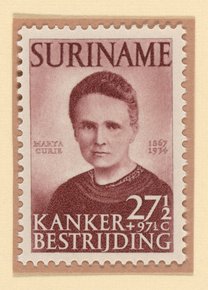Madame Curie, Descubridora del Radio
Mujeres Célebres, Año 2, Número 18
- 1962-Sep-10

Rights
Download all 6 images
PDFZIPof full-sized JPGsDownload selected image
Small JPG1200 x 1696px — 453 KBLarge JPG2880 x 4069px — 3.1 MBFull-sized JPG2964 x 4188px — 3.2 MBOriginal fileTIFF — 2964 x 4188px — 35.6 MBThe colorful letterpress halftone illustrations of this comic book tell a biographical account of the life and accomplishments of Marie Curie (1867-1934), the French physicist and chemist who pioneered radioactivity research and who discovered the elements polonium and radium. Curie was the first woman to win a Nobel Prize, the only woman to win two Nobel Prizes, and the only person to win the Nobel Prize in two separate fields. The comic begins with Curie's life as a young child in France and concludes with her death due to radiation exposure.
Mujeres Célebres (Famous Women) was a run of Mexican comic books published between 1961 and 1973, consisting of 160, 36-page comics. The collection includes comic-format adaptations of famous women's biographies. The comics were written and illustrated by indigenous Mexican authors and published by Editorial Novaro, headquartered in Mexico City. The now-defunct publishing house specialized in magazines (both printed and digital), pocketbook collections, recognized works of literature (especially for a youthful audience), and comic books including Spanish translations of many 1950s American comics.
Included in the digitization below are the comic's covers, introduction, and select illustrations. This work is protected by copyright law; to view the full text, contact or visit the Othmer Library of Chemical History.
| Property | Value |
|---|---|
| Publisher | |
| Place of publication | |
| Format | |
| Genre | |
| Extent |
|
| Language | |
| Subject | |
| Rights | In Copyright |
| Rights holder |
|
| Credit line |
|
Institutional location
| Department | |
|---|---|
| Collection | |
| Physical container |
|
Learn More
Related Items
Cite as
“Madame Curie, Descubridora Del Radio.” Mexico City, Mexico: Organización Editorial Novaro, September 10, 1962. QD28.C8 E35 1962. Science History Institute. Philadelphia. https://digital.sciencehistory.org/works/3nz58ef.
This citation is automatically generated and may contain errors.
Rights
Download all 6 images
Searchable PDFmay contain errorsZIPof full-sized JPGsDownload selected image
-
Keyboard Shortcuts
Previous image shift + or , Next image shift + or . Pan image Zoom in + or shift + Zoom out - or shift + Zoom to fit 0 Close viewer esc Also
Mouse click to zoom in; shift-click to zoom out. Drag to pan. Pinch to zoom on touch.










